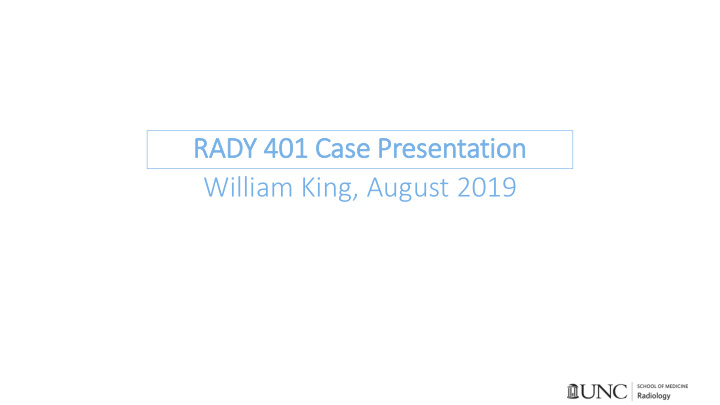



RADY 401 Case Presentation William King, August 2019
Focused pati tient his istory and workup • 32-year-old man with history of pericardial effusion s/p drainage presents to Womack Army Medical Center with worsening dyspnea on exertion and pleuritic chest pain • Found to have peripheral edema, but a BNP of 28. Kidney and liver function normal • Troponin 0.4 • Transthoracic echocardiogram 9/21/18: “Large heterogeneous echodensity (4.5cm in diameter) surrounding the RV and RA, with the appearance of invasion into the RA wall. This is concerning for malignancy.” • Transferred to UNC for “cardiac mass”
Li List of f im imaging stu tudies • Transthoracic echocardiogram • Portable AP (anterior-posterior) chest radiograph • Chest CT • PET-CT of the chest
Portable AP chest radiograph UNC • “Right paracardiac mass and bilateral parenchymal and subpleural nodular opacities, better assessed on the prior day outside the chest.”
Chest CT CT fr from outside hospital • "9.3 x 4.7 cm soft tissue lesion along the right heart wall, with mild mass effect on the lumen of the right atrium and right ventricle. No definite evidence of intracardiac thrombus.” • "Differential includes lymphoma and angiosarcoma and metastasis."
Chest CT CT fr from outside hospital – re pla lanned bio iopsy • "Numerous peripheral and subpleural pulmonary nodules with surrounding groundglass, measuring up to 1 cm.” • “Planning prescan CT images, reviewed with Dr. Yu at time of acquisition, did not demonstrate a window to perform the procedure safely without risk of complication.” “The receiver -operating-characteristic analysis revealed an optimal cutoff of 3 morphologic criteria, with a high specificity of 100% and a sensitivity of 70%. Using a threshold of malignancy of 4 or more morphologic criteria increased the positive predictive value to 100% at the cost of a lower sensitivity of 71%.” – Rhabhar et al.
PET CT CT UNC • "Soft tissue mass abutting the right cardiac wall is again visualized and demonstrates heterogeneous and intense uptake, worrisome for malignancy with necrotic areas." “An SUV max of 3.5 reveals a sensitivity of 100% and specificity of 86%, with a positive predictive value of 94% and a negative predictive value of 100%. With an SUV max of 4.6, the sensitivity drops to 94% and the specificity rises to 100%, with a positive predictive value of 100%.” – Rahbar et al.
Dia iagnosis and Treatment • Underwent biopsy via video-assisted thoracoscopic surgical biopsy of lung nodules • Pathology showed spindle cell proliferation and extensive hemangiovascular invasion consistent with low-grade metastatic angiosarcoma • Not a candidate for resection due to extensive involvement of right atrial free wall and numerous pulmonary metastases
Outcome • Underwent palliative chemotherapy and radiation with gemcitabine + docetaxel + external beam radiation to primary tumor • Now has innumerable metastases to lungs, liver, as well as concerning lesions in right ischium and spleen • Dismal prognosis
Im Imaging dis iscussion • Progressed through appropriate imaging studies • Classic presentation of cardiac angiosarcoma: • Right heart failure and/or tamponade • CT shows low-attenuation right atrial mass arising from right atrial free wall • Initial read contained cardiac angiosarcoma in differential Test Cost Radiation dose (mSv) TTE $2,467 0 2-view CXR $512 0.02 Chest CT $4,374 8 PET CT $5307 32 Source: www.fairhealthconsumer.org
Cardiac Angiosarcoma • Cardiac tumors are extremely rare (<0.1%). Of these, few (~15%) are malignant, but those that are usually (>80%) fatal • Diagnostic delays are common due to rarity • Classically presents with right heart failure or cardiac tamponade without heart disease or risk factors for heart failure • Two morphologic subtypes on imaging: 1. Low-attenuation mass arising from right atrial free wall 2. Diffusely infiltrative mass extending along pericardium • Hematologic metastasis to lungs typically occurs prior to diagnosis
Cardiac Angiosarcoma • Arises from right atrium • PET classically shows intense uptake of primary tumor (white arrowheads in figures B and E) and numerous foci of increased metabolic activity (seen in figure H) representing pulmonary metastases Hod et al.
UNC Top Three • Cardiac tumors are extremely rare (<0.1%). Of these, few (~15%) are malignant, but those that are usually (>80%) fatal. Cardiac angiosarcoma is one such malignant tumor. • One should suspect cardiac tumor in otherwise healthy patient with single-chamber heart failure. • Transthoracic echocardiogram is the first-line imaging test.
References • Muzio DB, Radswiki et al. Cardiac angiosarcoma. Radiopedia . Accessed 8/7/19. URL: https://radiopaedia.org/articles/cardiac-angiosarcoma?lang=us • Gaasch WH, Vander Salm TJ. Cardiac Tumors. UpToDate. Updated May 2019. Accessed 8/7/19. • Rahbar K et al. Differentiation of Malignant and Benign Cardiac Tumors Using 18 F-FDG PET/CT. J Nuc Med. 2012 Jun;53(6):856-63. • Lee CI, Elmore JG. Radiation-related risks of imaging. UpToDate. Updated Nov 2017. Accessed 8/7/19. • Huang B, Law MW, Khong PL. Whole-body PET/CT scanning: estimation of radiation dose and cancer risk. Radiology. 2009 Apr;251(1):166-74. • Janigan DT, Husain A, Robinson N. Cardiac Angiosarcomas: A Review and a Case Report. Cancer. 1986 Feb 15;57(4):852-9. • Chrysohoou C, Lalude O, Stillman A, Lerakis S. A Rare Case of Angiosarcoma of the Left Ventricle Detected by Cardiac Magnetic Resonance Imaging. Hellenic J Cardiol . 2015 Sep-Oct;56(5):444-5. • Hod N, Shalev A, Levin D, Anconina R, Ezroh Kazap D, Lantsberg S. FDG PET/CT of Cardiac Angiosarcoma With Pulmonary Metastases. Clin Nucl Med . 2018 Oct;43(10):744-746.
Recommend
More recommend